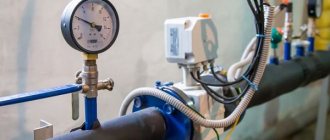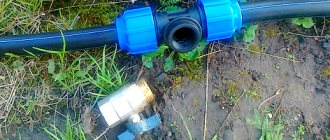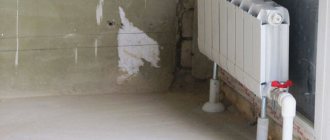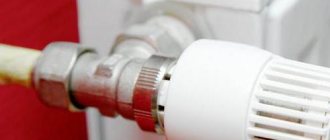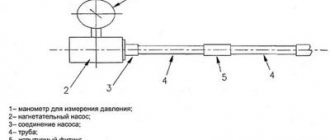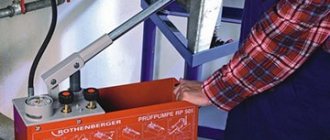Upon completion of the installation of engineering systems, the interested parties must sign the appropriate document - an inspection report for hidden work. Acts can be signed by representatives of the installation organization, general contractor, technical and architectural supervision, representatives of the Customer, representatives of the design organization, representatives of the operation service, authorized persons and others.
Certifies that the relevant engineering system is installed in accordance with the design. The act indicates what work has been submitted for inspection, who completed the detailed design, materials and equipment used during installation, the start and end dates of the work, the commission’s decision to accept the work and permission for further repair and construction work. If deviations from the design occurred during installation, this is also reflected in the report.
The hydraulic test certificate confirms
that the test was carried out and the system passed it. Hydraulic tests are carried out in accordance with building codes and regulations. Heating and water supply systems are tested using the hydrostatic or manometric method in accordance with SNiP 3.05.01-85 (internal sanitary systems). The hydrostatic method is more preferable. The test is carried out at a pressure equal to 1.5 times the maximum operating pressure. For different heating and water supply materials, the test time is different, but in any case not less than 10 minutes.
The water supply system is considered to have passed the test if, within 10 minutes of being under test pressure using the hydrostatic test method, no pressure drop of more than 0.05 MPa (0.5 kgf/cm²) and drops in welds, pipes, threaded connections, fittings and water leaks are detected through flushing devices. For a heating system, the pressure drop should not exceed 0.02 MPa (0.2 kgf/cm²).
Internal sewerage test
is carried out by pouring water by simultaneously opening 75% of the sanitary fixtures connected to this section of the sewer system. The system is considered to have passed the test if no leaks are detected through the walls of the pipelines and through the joints. Testing of internal drains is carried out by filling them with water to the highest point. The test time must be at least 10 minutes. The test is considered successful if no leaks are found during inspection and the water level in the risers has not decreased.
REPORT OF INSPECTION OF HIDDEN WORKS AND REPORTS OF HYDRAULIC TESTS (FORM)
Installation work, hidden work certificate
and the hydraulic test report are carried out by us in accordance with all building codes and regulations. When contacting “construction teams” and private craftsmen, you will not receive any agreed-upon working documentation, no correctly completed installation and as-built diagrams, or test reports on the actual work performed. Therefore, you will not receive any guarantees for installation work. As a rule, private teams do not have the qualifications, experience and knowledge to perform engineering and technical support of work. There are often cases when these unfortunate installers are not even able to speak Russian. What kind of compliance with building codes and regulations can we talk about? Therefore, if you want engineering systems to work correctly, last a long time and not cause you unnecessary trouble, contact qualified specialists.
guarantees high quality of work, clear documentary support for installation and design, and most importantly, attentive attitude towards you!
After all installation work on the arrangement of water supply communications has been completed, it is necessary to conduct a final test of the entire system in order to put it into operation in proper form. Tests are carried out to identify possible defects in the operation of communications and their subsequent elimination. The stages of inspection work and complete information on it are entered into the form of the act approved by SNiP. A sample or example of a document can be seen in our material below.
Find out how to correctly fill out the water supply system testing document form and what such work entails in our article.
Important: tests of finished internal water supply are in most cases carried out hydraulically using a large amount of water under pressure above the general average. If you have to test the external water supply, then at a temperature of +5 degrees you can still use the hydraulic method, and at lower temperatures the pneumatic method is used (pumping the communication with air under high pressure). Both methods are called pipe crimping in professional circles.
Filling out the first part of the act
Before performing testing (pressure testing) of a finished water pipeline, you must stock up on a report form in which all important data will be entered. The act is an official document from Appendix 1 of SNiP 3.05.04-85. The title of the document sounds like “Act on conducting an acceptance hydraulic test of a pressure pipeline for strength and tightness.”
The very first information that needs to be entered into the document is the city in which the testing work is being carried out and the date of the event. Below is a list of commission members who will test the internal/external water supply system.
As a rule, the commission should include:
- A representative of the organization that installed all communications;
- Representative from the customer's technical supervision service;
- Person representing the operating organization.
Moreover, it is worth registering the organization that the commission member represents, his position in it, and his last name with initials.
Below, it is mandatory to provide detailed information about the tested object. That is, enter its full name (can be taken from the project documentation), indicate the numbers of pickets located at the boundaries of the object, the total length of the water pipeline and its diameter, as well as the material from which the communication is installed and the pipe joints are made.
At this point, the “header” of the official document is considered completely filled out.
Carrying out system testing
- So, during the check, the water flow from each plumbing point is taken into account. It should be at least 0.2 liters per second.
- It is worth considering the water supply pressure. This is especially important for the highest water intake points. In this case, the pressure should be at least 2-3 meters.
- It is also worth checking the compliance of the parameters of the entire system according to the design documentation. Here they check the length, diameter of the pipeline, as well as the materials from which it is made.
- Visual initial inspection of external and internal communications also allows you to avoid strong gusts of the system as a result of testing.
- Pressure testing of a water supply system involves supplying water under high pressure to the system. Testing time is at least 10 minutes. The pressure when supplying water to the system should be one and a half times higher than the maximum permissible for a particular communication.
Example: household water supply can withstand a maximum gauge pressure of 0.45 MPa or just 45 meters of water column. Therefore, to test such sewerage and water supply systems, it is necessary to apply a gauge pressure equal to 0.675 MPa or simply 67.5 meters of water column.
Testing is considered successful if no leaks or ruptures in the water supply (sewer) pipeline are detected under the influence of water.
Text details
System pressure testing process
When carrying out pressure testing in order to identify problems, adhere to the following rules. During testing, it is necessary to take into account the water consumption rate from all points of consumption. The flow rate should be 0.2 liters per second. The level of flow pressure is also taken into account.
This parameter is important for water intake units that are located high. The pressure should be approximately three meters. During the inspection, the compliance of all system indicators specified in the documents is verified. It is important to check the length of the pipeline, the cross-section of the pipes, and the material of the parts. First, a visual inspection of all communications laid inside and outside is carried out. This will eliminate severe leaks in case of defects during testing. During pressure testing, water is supplied into the pipeline at high pressure.
Attention! The system is tested for more than ten minutes.
When water is supplied to the pipes, the pressure must exceed the permissible standards for these communications by 1.5 times. Eg:
For a household pipeline supplying water, the maximum permissible pressure is 0.45 milliamps, or 45 m of water column. To test the system, you need to use a pressure of 0.675 milliamps, or 67.5 m of water column.
Attention! The pressure testing process can be considered successful if there are no leaks or pipe breaks when they are exposed to water.
Further filling out the act
- After the pressure testing has been carried out, it is necessary to enter data on the nominal gauge pressure for a specific communication and data on the gauge pressure used in testing into the communication leak test report.
- It is also worth indicating the brand of pressure gauge that was used to test and measure the pressure readings in the system at the time of the test. Here it is necessary to indicate the height of the measuring device relative to the axis of the pipes.
- Another parameter that must be included in the leak test report for water supply or sewerage is the time during which the communication leak occurred.
- Further, the document indicates to what nominal value the pressure was reduced after the test. Lastly, members of the commission inspect the pipeline and sewerage and record the results in the report.
Important: the document should include all stages of communication research that were applied to a specific communication (did the pressure decrease periodically when water was supplied, was the water pressure changed, etc.).
- If there were no violations in the tightness of the water supply/sewage system, then in the “Check Results” column it is written down that at the time of the check no leaks or ruptures were found.
- Below is the item “Decision of the Commission”. If the tests are successful, the commission issues permission to put the water supply system into operation.
- Below, all members of the commission must put their signatures indicating their last name and initials, as well as their positions.
Hydraulic tests are carried out after completion of installation work; they are mandatory for pressure and non-pressure water supply networks. To carry out the tests, a pump is needed that pumps high pressure into the water supply, which reveals defects. The data obtained is included in the water supply testing report. Only after signing the act can the water supply be used.
Pressure test sequence for the heating system
This type of work must be planned in advance and therefore, before carrying out the work, appropriate documentation is drawn up:
- The work order is a permit signed by the responsible person of the organization servicing the heating network.
- A diagram of the sections of the heating main where the test will be carried out, indicating the pressure release points.
- List of employees authorized to conduct tests, including the responsible official.
- A diagram of the location of specialists in the area being inspected, indicating the means of communication between them.
- Description of the testing methodology and processing of the obtained data.
Before starting the pumping equipment, perform a visual inspection of the connections and the condition of the shut-off valves. Also, in order to isolate the heating system from the water supply pipeline, plugs are installed.
Then, according to the procedure, the heating boiler and expansion tank are turned off, and the pipes are flushed to remove deposits and debris no more than once every 4–6 years. This procedure must be performed, otherwise, due to the presence of a thick layer of plaque on the inner surface of the pipeline, its thermal conductivity is significantly reduced. Flushing is carried out in different ways depending on the technical condition of the heating structure.
When carrying out hydropressure testing, the flushed system is filled with water, after which a compressor is connected to the drain valve. The pressure is raised to the required value and the readings on the pressure gauge are observed. When there are no weak points in the pipes, which usually immediately leak, significant pressure fluctuations will not be noticed on the device. If this indicator drops significantly, you should find the location of the leak, which is not difficult to do.
Pneumatic pressure testing is performed using a special pump. To make it easier to find defects at the joints, you need to apply a soap solution to them before testing. The pump is connected to the system and air is forced into the pipes. Subsequent actions are similar to those during hydropressure testing. At the same time, it is necessary to remember to comply with safety precautions.
When breaks or loose connections are detected, the defects should be repaired and then checked again. This procedure is repeated until the system becomes completely sealed.
This is important to know: Complaints against the housing and communal services management company: sample statements
Pressure testing is carried out by specialists from organizations that have access, relevant knowledge and skills. They must be able to follow the sequence of work activities while ensuring safety. Finally, fill out the heating system pressure test form.
Purpose and order of testing
Hydraulic tests of water supply and wastewater systems are carried out to check the tightness, reliability of the water supply system and detect defective parts. Testing is prescribed before putting into operation a newly constructed network or after reconstruction (overhaul). All detected defects are immediately corrected, and tests are repeated until a satisfactory result is obtained. Tests are carried out twice: first preliminary
, after them
final
.
At the first stage, water is pumped into the water supply system under pressure; the pressure should be one and a half times higher than the working pressure. Preliminary hydraulic tests of water supply pipelines are prescribed with full access to the above-ground and underground parts of the pipeline, before the installation of plumbing fixtures.
Testing is scheduled before the final finishing of the premises. Hydraulic tests of drainage and water supply systems are carried out by specialists from the plumbing service.
Before the final stage of hydraulic testing of the water supply, the underground sections are closed, all installation work on the section is completed, but plumbing fixtures have not yet been installed. The exits are covered with plugs. During hydraulic tests of cold water supply, the pressure in the mains is increased by 1.3 times compared to the working one.
- Hydraulic tests of plastic water supply pipelines are allowed to be carried out a day after installation, at above-zero temperatures;
- To conduct hydraulic tests of drains in a house, the pipes are completely filled with water to the top of the risers. The condition of the pipes is first visually examined and noticeable defects are corrected. If a completely filled drainage system does not leak within 20 minutes, and the water remains at the marked level, the system has successfully passed the test.
How to draw up a heating system pressure test report - rules for completing the form
After completion of work related to pressure testing of the heating system, a special document is drawn up confirming that the heat supply structure is ready for winter. A special form is provided for this. It is called the act of pressure testing the heating system.
The main task of this type of plumbing work is to test the quality of the pipeline assembly, determine how ready it is for operation, and check the tightness of all joints. If defects are identified that were not visible during external inspection, they should be eliminated.
This is important to know: Debt for housing and communal services: statute of limitations according to the law of 2021
Pressure testing is considered an important stage in the arrangement of heat supply in buildings for a wide variety of purposes.
This work is performed in certain situations:
- before the start of the autumn - winter season;
- after completing the installation of the new heating circuit;
- when the repair or reconstruction of the entire heating main or its section is completed;
- after construction work carried out in the building.
Test conditions
It is necessary to carry out hydraulic tests of water supply and wastewater systems with full responsibility, recognizing the complexity of the procedure. The result of the tests largely depends on the skill of their implementation. Therefore, they are trusted only to specialists who know the safety measures and requirements for such checks.
- The temperature indoors or outdoors (if the external water supply is checked) is not lower than +5 degrees;
- The water pipeline is filled gradually, starting from the main section. Then the water is poured into risers and small local networks;
- The lower floors are filled first, gradually rising higher. This is necessary to displace air from the pipes and prevent the formation of air locks;
- At the end of the hydraulic tests, the used water is drained from the water supply and drainage system;
- During hydraulic tests of hot water supply, the temperature is measured at the extreme sections of the system. Water of the design temperature is poured into the system;
- During hydraulic testing of hot water supply, the condition of heated towel rails in bathrooms is tested;
- If it is necessary to test the efficiency of the water supply system, all points of use in the riser are turned on at the same time. This test step is optional.
Documentation of the work performed - act
The pressure test certificate is an official document with legal force confirming that:
- tests were carried out in full according to the program developed by the engineer, in accordance with current standards;
- the heat supply system is in working order and prepared for operation;
- in the event of an emergency during the heating season, one or both parties will be responsible for it, and the culprit will compensate for the damage.
In the form of an act for hydraulic testing of the heating system, there are columns that must be filled out completely and as accurately as possible.
- name of the object being checked;
- date and time of the pressure test;
- the tested area, which can be, for example, a heating main or a separate unit;
- devices used;
- results of visual inspection of joints, seams, etc.;
- the magnitude of the operating pressure and load on the system and the duration of the tests;
- values on the pressure gauge at the end of the test;
- the magnitude of the pressure drop;
- information on eliminating leaks and other defects;
- conclusion that the system is ready for operation;
- signatures of authorized persons.
The heating main pressure test certificate is signed on the day the system was tested. This document must be endorsed by the responsible persons of the enterprise that carried out the work, as well as the technical supervision body and the management company.
Preliminary test progress
The procedure for conducting preliminary hydraulic testing is regulated by the Construction Norms and Rules:
- The water supply is filled and left without pressure for two hours.
- Increased pressure is slowly created for half an hour. Then you can check for leaks at the joints.
- The pressure is reduced to the calculated values, and the condition of the route is examined.
- The route remains under this pressure of water for 30 minutes or more to stabilize the deformed shape of the pipes.
- The inlet taps are closed and the water is slowly drained from the pipes using a pressure testing pump.
- The route is checked for leaks and noticeable problems.
The water supply system has successfully passed inspections when no leaks are detected at increased pressure, connections and fastening elements are intact.
Before starting a hydraulic test of a water supply system in an apartment building, you should find out the standard operating pressure and check it with the pressure limits of the devices (manifolds, hoses, filters, sensors).
Progress of the final test
In multi-apartment residential buildings, the final hydraulic test of the cold water supply is carried out after the installation of plumbing fixtures:
- The working pressure is pumped into the water supply and maintained for two hours. If the pressure decreases by 0.02 MPa, it is raised to the initial level.
- In 10 minutes the pressure is increased to test values and maintained for two hours.
Hydraulic testing of the cold water supply system is considered successful if the leakage is not higher than the readings in the table.
| diameter , cm | Allowed leakage, liter/min | |
| For welded joints | For connections on seals (sockets) | |
| 6,3-7,5 | from 0.2 to 0.24 | from 0.3 to 0.5 |
| 9-11 | from 0.26 to 0.28 | from 0.6 to 0.7 |
| 12,5-14 | from 0.35 to 0.38 | from 0.9 to 0.95 |
| 16-18 | from 0.42 to 0.6 | from 1.05 to 1.2 |
| 20 | 0,56 | up to 1.4 |
| 25 | 0,7 | up to 1.55 |
| 28 | 0,8 | up to 1.6 |
| 31,5 | 0,85 | up to 1.7 |
| 35,5 | 0,9 | up to 1.8 |
| 40-45 | from 1.1 to 0.5 | from 1.95 to 2.1 |
| 50-56 | from 1.1 to 1.15 | from 2.2 to 2.3 |
| 63 | 1,2 | up to 2.4 |
| 71 | 1,3 | up to 2.55 |
| 80 | 1,35 | up to 2.7 |
| 90 | 1,45 | up to 2.9 |
| 100 | 1,5 | until 3 |
| 120 | 1,6 | until 3 |
Table 1.
Permitted volumes of leaks on a 1 km section of water pipeline
The data obtained as a result of hydraulic tests is entered in as much detail as possible into the acceptance certificate of the water supply system. This also includes information about alterations and repairs made during the tests. The water supply testing report is proof of the quality and excellent condition of the water supply system and readiness for operation.
Upon completion of hydraulic tests, the following documents are required for commissioning of a cold or hot water supply system: working materials with notes on the features of the installation of the water supply system and the coincidence of the final result with the project, a description of the changes; hydraulic test certificate; act describing hidden work.

